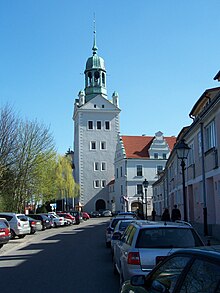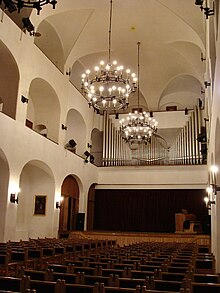Castle Church of Stettin
The castle church in Stettin was a Protestant church building within the building complex of the Stettin castle . Today it is used as a concert hall.
Building history
The Ottenkirche , built in 1346, originally stood around the site of today's castle church . The Pomeranian Duke Johann Friedrich had the Ottenkirche demolished in 1575 because it was in disrepair and a new church building was built in 1577, which was integrated into the north wing of the castle and which was now referred to as the castle church.
The castle church is the oldest church building in Pomerania , which was built from the outset as a Protestant church, in the form of the transverse church with circumferential galleries and the pulpit on the northern long side. As before the Ottenkirche, the castle church now served as the burial place of the Pomeranian dukes from the Greifenhaus . The interior decoration included a renaissance altar by Johann Baptist Perino and a magnificent epitaph (grave monument) made of wood for Duke Bogislaw X. of Pomerania.
The walls were whitewashed in the 18th century. The church and tower were quite dilapidated, “so that the bells could not be rung without danger and considerable head shaking from the tower. The pulpit was attached to a pillar in the middle of the church, so that the spaces between the pulpit and the altar were worthless. "
"The access from the tower was scrambled and blocked by a wooden staircase, the access to the galleries was via a wooden gallery from the outside, not without danger to life - in 1814 a child fell down and died in a fatal accident." the galleries demolished and the entrances to the choirs relocated inside.
In 1822 the organ builder Friedrich Grüneberg presented a draft for a new organ, but negotiations dragged on until 1837. In 1837 the organ builder Johann Friedrich Schulze from Paulinzella sold a small organ with 12 voices that he had built as an interim organ in the cathedral in Halberstadt .
The number of civil servants in Szczecin grew considerably - and with it the number of community members. The senior community president Ernst Senfft von Pilsach obtained funds of 6,700 thalers from the ministry for the necessary expansion. In 1862 the church was rebuilt, increasing the number of seats from 650 by 389 to over 1000. The flags and armor attached to the pillars were removed and taken to Berlin. Three new galleries were built on the north side and the pulpit was moved near the altar . “The choir under the organ was shortened after the tower, the wooden stairs removed and a dignified, arched exit was created, which also had benches to sit on. A staircase from the Münzhof now led to the galleries. The altar, which stood right against the wall, was moved forward. ”To fix the pillars, the princely crypt, in which at least 25 members of the Pomeranian ducal house are buried, was found opened and robbed. The orchel choir was expanded and stucco strips were attached to the ceiling “so that the impression of a cross vault was created. The windows, previously only simple house windows, were replaced by right church windows, the doors were renewed, the ceiling and the walls were newly decorated, the pictures and the carvings were renewed, the seating was painted an oak-colored paint and the whole church was given gas lighting instead of the previous oil lamps The inauguration took place on the 4th Advent in 1862. “The organ was renewed under Schiffmann [1751], but the mice even grabbed the wooden organ pipes, and the entablature also had to be supported.” Until in 1864 the organ was rebuilt by the Szczecin organ builder Barnim Grüneberg with 23 sounding voices . The cost of the renovation amounted to 10,638 thaler, plus the organ with 2,451 thaler.
In the years 1908/1909 the church was rebuilt and expanded again. “Central heating was installed for the gas stoves installed after 1862, while the previous gas lighting was replaced by electrical ones, and the organ was almost completely rebuilt. Above all, however, the interior of the church was completely redesigned. ”The stucco ribs from 1862 were torn down, but the interior was painted bright and colorful with foliage by the painter Paul Kutschmann from Friedenau in the Renaissance style. On the occasion of the celebration of the new consecration of the church, Ulrich Hildebrandt's chorale cantata (op. 16) "Now cheers for the Lord all the world" was premiered on May 21, 1909 .
During the Second World War , the entire Szczecin ducal palace was badly damaged, including the palace church, the interior of which was destroyed.
Bell scratch drawings
The Otto bell , cast in 1471, had rare, art-historically significant carved bell drawings , which are honored in a work by the art historian Ingrid Schulze from 2006.
Castle parish
The evangelical castle church community was a personal community to which the officials resident in Stettin belonged. From 1804 the castle parish was connected to the parish of the former Stettiner Marienkirche as a castle and Marienkirche parish.
Pastor at the castle church
The castle church pastors were court preachers until 1919.
- 1545 Bernhard straw cutter
- ? -1563 Paul von Rhoda (?)
- 1563–1570 Fabian Timaeus
- 1577–1595 (?) Jakob Faber
- Nikolaus Ribbius
- 1604–1618: David Reutzius
- 1618–1626: Johann Bütow
- 1626–1654: Jakob Fabricius
- ? –1663: Matthias Decenius
- Erdmann Schwarzkopf
- Samuel Hollmann
- 1701–1710: Christoph Adam Fabricius
- 1710–1726: Laurentius David Bollhagen
- 1727–1738: Johann Gottfried Hornejus
- 1739–1772: Christian Sigismund Schiffmann
- 1773–1817: Ludwig Wilhelm Brüggemann
- 1818–1862: Heinrich Wilhelm Gottfried Richter
- 1863: Paul Fischer
- 1864–1879: Friedrich Wilhelm Gustav Carus , then General Superintendent of the Church Province of Prussia
- 1880–1899: Hermann Robert Rudolf Brandt
- 1900–1905: Wilhelm Haupt
- 1906–1912: Christian Rogge
- 1912–1920: Gotthold Würkert
- 1920–1921: Deputy: Pastor Katter (1881–1923 'Deacon')
- 1921-1936: Maximilian Meyer
- 1939–1945: Willi Büsching-Krüger
Organists at the castle church
- 1695–1729 Christoph Schmidt (1655–1729)
- 1729–1745 Johann Christian Stürmer
- 1745–1789 Christian Michael Wolff (1707–1789, Marian organist since 1732)
- 1751–52 new organ ( Johann Peter Migendt , 1 manual, 13 sounding voices)
- 1789–1825 Friedrich Wilhelm Haack (1765–1825)
- 1825–1858 Ferdinand Oelschläger (1798–1858)
- 1838 New organ (Joh. Fr. Schulze, 2 manuals and pedal, 12 sound. St. (?))
- 1859–1898 Carl Gustav Flügel (1812–1900)
- 1862–64 new organ (Barnim Grüneberg, Op. 70, 2 manuals and pedal, 23 sound. Sti.)
- 1898–1940 Ulrich Hildebrandt (1870–1940)
- 1909 almost complete organ reconstruction (Grüneberg)
- 1940–1945?
Use since 1945
On July 5, 1945, Stettin was handed over to the Polish state by the Soviet power . The Polish authorities expelled the native German population who had not fled. This was predominantly of the Protestant denomination, so that further use as a Protestant church was unnecessary, but was not possible because of the destruction. The Szczecin Ducal Palace was rebuilt in the 1950s; The exterior of the castle church building was also restored for the time being. Only after 2000 was the interior reconstructed and restored. It has been used as a concert and theater hall ever since.
The last object to be restored was the crypt under the castle church, in which the coffins of the Pomeranian dukes stood until before the war. Until the restoration of the crypt, the coffins were then in a basement room in the east wing and were restored and exhibited there. After excavations in the crypt and the structural reconstruction, the rooms were then prepared again as a burial place with exhibition character.
literature
- Johannes Hinz : Pomerania. Signpost through an unforgettable country. Flechsig-Buchvertrieb, Würzburg 2002, ISBN 3-88189-439-X , p. 349.
- Horst Kramp: burial place of the Pomeranian dukes. In: Stettiner Bürgerbrief. No. 34, 2008, ISSN 1619-6201 , pp. 20-22.
Footnotes
- ↑ a b c d Paul Meinhold: History of the castle and Mariengemeinde. Stettin 1926, p. 89f.
- ^ Paul Meinhold: History of the Castle and Mariengemeinde. Stettin 1926, p. 111.
- ↑ Wolf Bergelt : A silent image sound for the castle church in Stettin. 2008 ( PDF ).
- ^ Paul Meinhold: History of the Castle and Mariengemeinde. Stettin 1926, p. 91.
- ^ Paul Meinhold: History of the Castle and Mariengemeinde. Stettin 1926, p. 100.
- ^ Ingrid Schulze: Incised drawings by lay hands - drawings by medieval sculptors and painters? Figural bell scratch drawings from the late 13th century to around 1500 in central and northern Germany. Leipzig 2006, ISBN 978-3-939404-95-8 .
Coordinates: 53 ° 25 ′ 35.2 ″ N , 14 ° 33 ′ 36.2 ″ E




